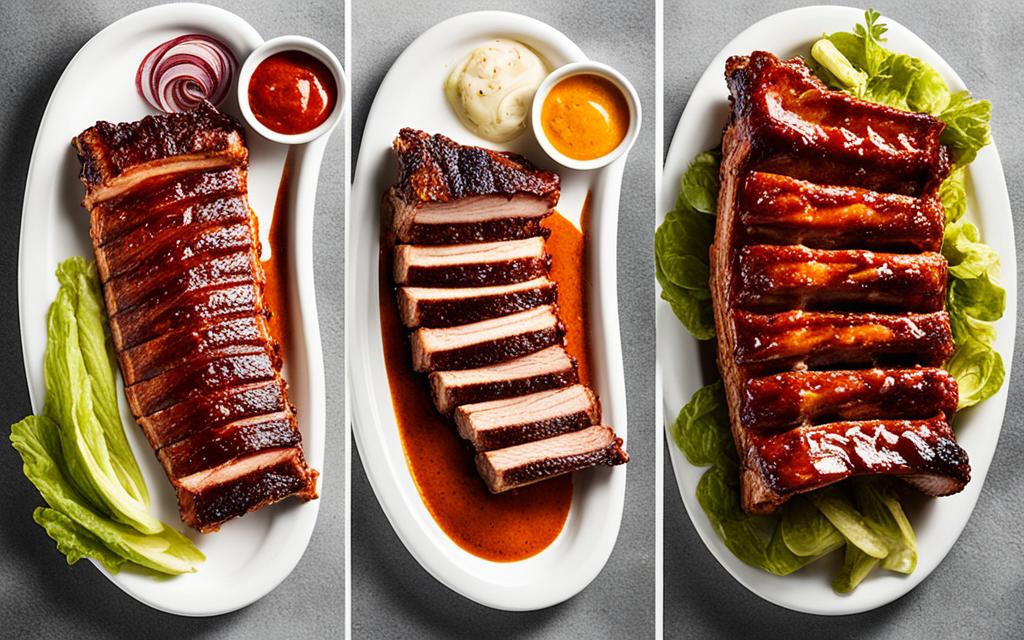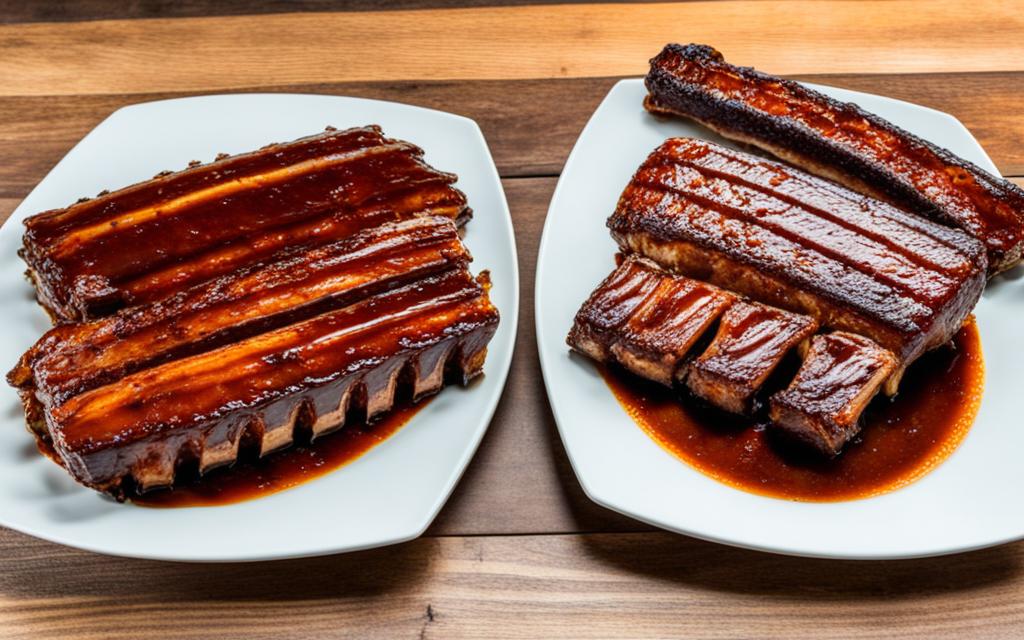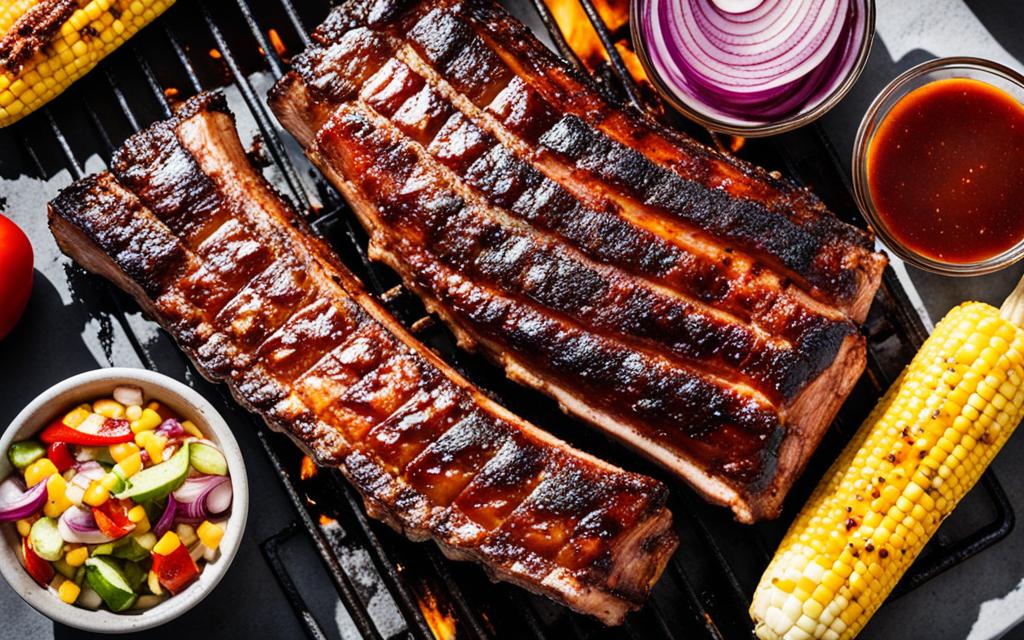Are you ready to take your grilling skills to the next level? In this article, we will explore the differences between baby back ribs vs spare ribs, two popular cuts of pork ribs. Not only will you discover the nuances of flavor, texture, and cooking methods, but you’ll also learn valuable tips to enhance your rib game. Get ready for a mouthwatering adventure!
When it comes to ribs, there’s a lot to savor. Baby back ribs, also known as back ribs or loin ribs, are a favorite among BBQ enthusiasts. On the other hand, spare ribs, also called side ribs, are a staple on many BBQ menus. Each cut has its own unique qualities that make them stand out.
So, what sets baby back ribs and spare ribs apart? Let’s dive in and discover the taste difference between these delectable cuts!
Key Takeaways:
- Baby back ribs and spare ribs are both popular cuts of pork ribs.
- Baby back ribs are shorter, leaner, and known for their tender meat.
- Spare ribs are longer, meatier, and have a higher fat content.
- Baby back ribs have a mild, subtle flavor, while spare ribs offer a richer taste.
- Both cuts can be cooked using various methods, such as grilling and smoking.
What are Baby Back Ribs?
Baby back ribs are a cut of pork ribs taken from the top of the rib cage near the spine. They are shorter in length and tend to be leaner compared to spare ribs. Baby back ribs are known for their tender meat and a higher ratio of meat to bone.
When it comes to cooking baby back ribs, it’s important to keep a few tips in mind to ensure flavorful, juicy results. Here are some helpful cooking tips to bring out the best in baby back ribs:
- Remove the membrane: Before cooking, remove the thin membrane from the back of the ribs. This will allow for better seasoning penetration and tender meat.
- Marinate or dry rub: Enhance the flavor of baby back ribs by marinating them overnight or applying a dry rub. This helps to infuse the ribs with delicious spices and seasonings.
- Low and slow cooking: Baby back ribs benefit from slow cooking over indirect heat. This method allows the meat to become tender and succulent without drying out.
- Baste with sauce: During the last stage of cooking, brush the ribs with your favorite barbecue sauce to add a sticky and caramelized glaze.
- Rest before serving: After cooking, let the baby back ribs rest for a few minutes. This allows the juices to redistribute throughout the meat, resulting in a more flavorful bite.
Try these cooking tips to achieve perfectly cooked baby back ribs that will impress your family and friends. With a little practice and attention to detail, you’ll be able to savor the deliciousness of tender, meaty baby back ribs every time you grill or smoke them.
What are Spare Ribs?
Spare ribs, like their name suggests, are a flavorful and meaty cut of pork ribs that come from the lower portion of the rib cage, closer to the belly. These ribs are longer in length and offer a generous amount of tender meat, making them a popular choice among rib enthusiasts. What sets spare ribs apart is their higher fat content, which adds richness and succulence to the meat when cooked properly. If you’re looking to elevate your grilling game and achieve juicy, melt-in-your-mouth spare ribs, here are some valuable cooking tips to keep in mind:
- Cooking method: Spare ribs can be prepared using various cooking methods, including grilling, smoking, baking, or braising. Each method imparts a different flavor and texture to the ribs, so choose the one that suits your taste preferences.
- Marinade or dry rub: Enhance the flavor of spare ribs by marinating them overnight or applying a dry rub before cooking. This allows the flavors to penetrate the meat and infuse it with deliciousness.
- Low and slow cooking: Spare ribs benefit from slow cooking at a low temperature to ensure tender meat and render the fat. This can be achieved by using indirect heat on a grill or by smoking the ribs for several hours.
- Basting: To keep the spare ribs moist and add extra flavor, baste them with a sauce or marinade during the cooking process. This helps prevent the meat from drying out and creates a mouthwatering glaze.
- Proper resting: After cooking, let the spare ribs rest for a few minutes to allow the juices to redistribute throughout the meat. This step ensures more flavorful and juicy ribs when you take that first bite.
Now that you have some expert cooking tips in your arsenal, go ahead and indulge in the joy of preparing juicy and succulent spare ribs. With every bite, savor the rich flavors and tender meat that spare ribs have to offer. Trust us, your taste buds will thank you!
Flavor Comparison
When it comes to flavor, baby back ribs and spare ribs offer distinct taste experiences. The difference lies in their varying flavors, allowing you to choose based on your personal preferences. Let’s delve into the flavor profiles of both cuts.
Baby Back Ribs: Mild and Subtle
Baby back ribs are renowned for their mild and subtle taste. These ribs have a delicately flavored meat that allows the true essence of your rubs or sauces to shine through. With every bite, you’ll savor a hint of smokiness complemented by the flavors you choose to enhance them with. Whether it’s a tangy barbecue sauce or a savory rub, baby back ribs provide a perfect canvas for your culinary creations.
Spare Ribs: Rich and Flavorful
On the other hand, spare ribs boast a richer and stronger flavor profile. The higher fat content in spare ribs contributes to their intense and mouthwatering taste. As you sink your teeth into these meaty ribs, you’ll experience a culinary journey of bold flavors and succulent textures. The marbling of fat throughout the meat imparts a richness that elevates the overall taste, making every bite unforgettable.
Both baby back and spare ribs offer unique flavors that can satisfy different palates. Whether you prefer a milder taste or crave a more robust flavor, these ribs cater to your individual preferences.
To visually illustrate the flavor comparison between baby back and spare ribs, let’s take a look at this table:
| Rib Type | Flavor |
|---|---|
| Baby Back Ribs | Mild and subtle |
| Spare Ribs | Rich and flavorful |
Now that we’ve explored the flavor profiles of baby back and spare ribs, you can choose the right cut based on your desired taste experience. Enjoy experimenting with different flavors, rubs, and sauces to create a culinary masterpiece that will leave your taste buds craving more.
Texture Comparison
When it comes to enjoying ribs, texture plays a crucial role. The texture of the meat can greatly impact your overall dining experience, and this is true for both baby back ribs and spare ribs.
Baby back ribs are well-known for their tender and delicate texture. The meat practically melts in your mouth, offering a truly succulent and satisfying bite. Each tender rib offers a delightful combination of flavorful meat and just the right amount of tenderness.
Spare ribs, on the other hand, have a slightly chewier texture. Some people prefer this slight resistance when biting into spare ribs, as it adds an enjoyable element to the eating experience. The meat is still juicy and moist, but with a bit more bite.
To truly understand the textural differences between baby back and spare ribs, it’s essential to indulge in both and see which one suits your preferences best. Whether you prefer the melt-in-your-mouth tenderness of baby back ribs or the chewier texture of spare ribs, both options offer a delightful journey for your taste buds.
Explore the distinct textures of baby back and spare ribs for a truly satisfying dining experience.
Cooking Methods
When it comes to cooking baby back and spare ribs, there are various methods to choose from. However, the two most popular options are grilling and smoking. Each method has its own unique advantages and can result in mouthwatering, flavorful ribs that will impress your guests. Let’s explore the nuances of these cooking methods to achieve restaurant-quality results.
Grilling Baby Back Ribs
Grilling baby back ribs is a classic choice that yields delicious results. The direct heat of the grill creates a slightly charred exterior that adds a delightful texture to the ribs. Additionally, grilling imparts a smoky flavor that perfectly complements the natural sweetness of the meat. To achieve the best results, follow these tips:
- Preheat your grill to medium heat.
- Season the ribs with your favorite rub or marinade.
- Place the ribs bone-side down on the grill.
- Cook for about 2-3 hours, turning occasionally and basting with sauce if desired.
- Check for doneness by inserting a fork between the bones; the meat should be tender and easily come off the bone.
Smoking Spare Ribs
If you’re looking for a more intense and rich smokiness, smoking spare ribs is the way to go. Smoking involves cooking the ribs over indirect heat for a longer period, allowing the meat to absorb the smoky flavors from wood chips or pellets. To achieve tender and flavorful smoked spare ribs, follow these steps:
- Preheat your smoker to a temperature of 225°F (107°C).
- Apply a dry rub or marinade to the ribs.
- Place the ribs in the smoker, bone-side down.
- Add wood chips or pellets to the smoker for added smoke flavor.
- Smoke the ribs for about 5-6 hours, or until the meat is tender and pulls away from the bone easily.
Experimenting with different cooking methods can lead to exciting flavor profiles and culinary discoveries. Whether you choose to grill or smoke your ribs, the key is to give them the time and attention they deserve. So fire up your grill or smoker, and get ready to create a mouthwatering feast that will leave your guests craving more.
Recipe Comparison
Choosing the right recipe for your ribs can make all the difference. To help you find the best choice for your next cookout, we have compared different recipes specifically designed for baby back and spare ribs. Explore these mouthwatering recipes and elevate your rib game to the next level.
When it comes to baby back ribs, one recipe stands out:
Classic Honey Glazed Baby Back Ribs
Add a touch of sweetness to your baby back ribs with this classic honey glazed recipe. The combination of honey, brown sugar, and spices creates a harmonious blend of flavors that perfectly complements the tender meat. Follow our step-by-step instructions to achieve fall-off-the-bone goodness.
For spare ribs enthusiasts, we recommend trying this delicious recipe:
Savory Smoked Spare Ribs with Barbecue Sauce
Indulge in the rich and smoky flavors of these savory smoked spare ribs. The slow cooking process combined with a homemade barbecue sauce infuses the meat with tantalizing taste. Impress your guests with tender and flavorful spare ribs that will have them coming back for seconds.
Experiment with these recipes and discover which one suits your taste buds and grilling style. Whether you choose the classic honey glazed baby back ribs or opt for the savory smoked spare ribs with barbecue sauce, both recipes are guaranteed to be a hit at your next barbecue gathering.
Cooking Tips
When it comes to cooking baby back and spare ribs to perfection, having a few expert tips and tricks up your sleeve can make all the difference. Whether you’re a seasoned pro or a novice griller, these tips will help you elevate your rib game and impress your friends and family with mouthwatering results.
1. Marinating and Seasoning
To enhance the flavors of your ribs, start by marinating them in your favorite sauce or seasoning blend. Allow the ribs to marinate for a few hours or overnight in the refrigerator, allowing the flavors to penetrate the meat. When it’s time to cook, remember to season your ribs generously with salt, pepper, and any additional spices or herbs of your choice.
2. Preparing the Grill or Smoker
Before placing your ribs on the grill or in the smoker, ensure that it is preheated to the proper temperature. For grilling, preheat the grill to medium heat (around 325°F to 350°F). If you’re using a smoker, aim for a lower temperature of around 225°F to 250°F. Consistency in temperature is key to achieving even cooking and tender ribs.
3. Indirect Heat and Low and Slow
For both baby back and spare ribs, the key to tender and juicy results is cooking them using indirect heat and a low and slow method. This means placing the ribs away from direct flames or heat sources and cooking them at a lower temperature for a longer period. This technique allows the collagen in the meat to break down, resulting in tender and flavorful ribs.
4. Wrapping in Foil
If you prefer fall-off-the-bone tender ribs, try the foil-wrapped method. After the initial cooking time, wrap the ribs tightly in aluminum foil, adding a bit of liquid such as apple juice or broth to help steam and tenderize the meat. Return the wrapped ribs to the grill or smoker for an additional cooking time. The foil helps trap moisture, creating tender and succulent ribs.
5. Monitoring Internal Temperature
While cooking ribs, it’s crucial to monitor the internal temperature using a meat thermometer. For baby back ribs, the ideal temperature is around 180°F to 190°F, while spare ribs should reach 190°F to 205°F. This ensures that the meat is properly cooked and tender. Remember to insert the thermometer probe into the thickest part of the meat, avoiding contact with bones.
6. Resting and Slicing
After removing the ribs from the heat, allow them to rest for a few minutes. This allows the juices to redistribute, resulting in more flavorful and juicy ribs. When it’s time to slice the ribs, use a sharp knife to cut between the bones, creating individual rib portions. Serve them hot and enjoy!
With these expert cooking tips, you’re well-equipped to become a rib-master, whether you choose baby back or spare ribs. Experiment with different flavors, techniques, and recipes to find your personal best choice. Wow your guests with perfectly cooked ribs that will have them coming back for more.
Best Choice: Baby Back or Spare Ribs?
After exploring the flavor, texture, and cooking methods of baby back and spare ribs, the ultimate question remains – which one is the best choice for you? Let’s weigh the pros and cons of each cut to help you make an informed decision.
The Case for Baby Back Ribs
If you prefer a milder flavor and a tender, melt-in-your-mouth texture, baby back ribs are the way to go. These ribs are leaner and have a higher meat-to-bone ratio, resulting in a meaty bite with less fat. Their smaller size also means they cook more quickly, making them a great option for those who want to get their ribs on the table faster.
The Case for Spare Ribs
Spare ribs offer a richer taste and a meatier texture. With their higher fat content, these ribs pack a punch of flavor that can stand up to bold seasonings and sauces. They have longer bones and more marbling, which contributes to their succulence and juiciness. Spare ribs take a little longer to cook but are well worth the wait for those who enjoy indulging in a more substantial, satisfying rib experience.
Now, let’s compare baby back and spare ribs side by side:
| Baby Back Ribs | Spare Ribs | |
|---|---|---|
| Flavor | Mild and subtle | Rich and flavorful |
| Texture | Tender and delicate | Meaty and slightly chewy |
| Cooking Time | Quicker | Longer |
| Meat-to-Bone Ratio | Higher | Lower |
Consider your personal preferences and cooking style when deciding which ribs are the best choice for you. Are you looking for a more subtle and tender experience, or do you crave a bold and meaty bite? It’s all about finding the perfect balance of flavor, texture, and cooking time that satisfies your cravings and elevates your grilling game.

Explore different recipes, experiment with cooking methods, and don’t be afraid to mix and match flavors to create your signature rib masterpiece. Whichever cut you choose, baby back or spare ribs, one thing is certain – you’re in for a mouthwatering treat that will impress your friends and family at any barbecue gathering.
Conclusion
In conclusion, baby back ribs and spare ribs both have their own unique qualities. Baby back ribs are known for their tender meat and mild flavor, making them a popular choice for those who prefer a delicate taste. On the other hand, spare ribs offer a richer taste and meatier texture due to their higher fat content, appealing to those who enjoy a more robust flavor.
The choice between baby back and spare ribs ultimately comes down to personal preference. Some may prefer the melt-in-your-mouth tenderness of baby back ribs, while others may enjoy the slightly chewier texture of spare ribs. It’s all about finding the perfect balance between flavor, texture, and cooking method to create the ultimate rib experience.
To find your perfect rib experience, don’t be afraid to experiment with different cooking methods, recipes, and flavors. Whether you choose to grill or smoke your ribs, apply a dry rub or slather them with sauce, the result will be a mouthwatering delight that will impress your guests at any barbecue gathering.
So, go ahead and indulge in the joy of cooking ribs. Whether you’re a fan of baby back or spare ribs, the world of flavors and sensations that awaits you is truly remarkable. Discover your personal favorite and elevate your grilling game to new heights, one succulent rib at a time!
FAQ
What are the differences between baby back ribs and spare ribs?
Baby back ribs are taken from the top of the rib cage near the spine and tend to be leaner and shorter in length. Spare ribs come from the lower portion of the rib cage and are longer and meatier. Spare ribs also have a higher fat content compared to baby back ribs.
How do baby back ribs and spare ribs differ in flavor?
Baby back ribs have a mild and subtle flavor, allowing the flavors of rubs or sauces to shine through. Spare ribs have a richer and stronger flavor due to their higher fat content, resulting in a more flavorful eating experience.
What is the texture difference between baby back ribs and spare ribs?
Baby back ribs have a tender and delicate texture, often described as melt-in-your-mouth. Spare ribs have a slightly chewier texture, which some people find appealing.
What are some cooking methods for baby back and spare ribs?
The most popular cooking methods for both baby back and spare ribs are grilling and smoking. Grilling baby back ribs gives them a slightly charred exterior and a smoky flavor, while smoking spare ribs results in a more intense and rich smokiness.
Can you provide recipe comparisons for baby back and spare ribs?
We compare different recipes specifically designed for baby back and spare ribs to help you find the best choice for your next cookout. Try out these mouthwatering recipes and elevate your rib game to the next level.
What are some cooking tips for baby back and spare ribs?
Learn expert cooking tips and tricks for both baby back and spare ribs. From marinating and seasoning to achieving the perfect tenderness, these tips will help you become a rib-master in no time.
Which is the best choice between baby back and spare ribs?
The best choice between baby back and spare ribs ultimately depends on personal preference. Weigh the pros and cons of each cut and experiment with different cooking methods, recipes, and flavors to find your perfect rib experience.









